Cân bằng máy ly tâm công nghiệp: Ngừng rung lắc và tránh thời gian chết
Vấn đề: Một máy ly tâm công nghiệp trong một nhà máy dệt gia dụng (dùng để giặt và sấy gối) rung lắc dữ dội, làm rung chuyển cả sàn nhà. Tiếng ồn không chỉ khiến nhân viên lo lắng mà còn gây thêm áp lực lên ổ trục và kết cấu của máy. Tình huống này thường gặp ở nhiều nhà máy: một máy ly tâm mất cân bằng có thể âm thầm tiêu tốn ngân sách bảo trì và dẫn đến những hỏng hóc bất ngờ.
Ngay cả một sự mất cân bằng nhỏ cũng có thể gây ra tác động rất lớn. Ở tốc độ khoảng 3000 vòng/phút, một khối lượng lệch tâm nhỏ 10 gram có thể tác động lực khoảng 30 kg lên ổ trục rotor. Tốc độ tăng gấp đôi, lực đó tăng gấp bốn lần - có khả năng lên đến hơn 100 kg từ cùng một khối lượng nhỏ đó. Giải pháp: Tin tốt là bằng cách cân bằng rotor máy ly tâm đúng cách, bạn có thể loại bỏ những rung động phá hoại này. Trong bài viết này, chúng tôi sẽ giải thích lý do tại sao máy ly tâm rung, cách nhận biết các dấu hiệu cảnh báo mất cân bằng, và quan trọng nhất là cách thực hiện cân bằng động rotor từng bước. Quá trình này có thể được thực hiện tại chỗ bằng máy phân tích di động, giúp khôi phục hoạt động trơn tru và tiết kiệm chi phí. tiền bạc (từ việc giảm thiểu thiệt hại và thời gian chết), thời gian (bằng cách tránh việc tắt máy không theo kế hoạch) và đảm bảo độ tin cậy and sự an toàn trong hoạt động của bạn.
Trong video dưới đây, bạn có thể xem một ví dụ về sự cố này và cách khắc phục tại nhà máy sản xuất gối. Máy giặt công nghiệp (máy ly tâm) bị rung lắc mạnh trước khi cân bằng, và sau khi thực hiện quy trình cân bằng với thiết bị Balanset-1A, máy đã hoạt động trơn tru:
Hiểu về độ rung và mất cân bằng trong máy ly tâm
Rung động là gì? Trong máy ly tâm, rung động là chuyển động dao động hoặc rung lắc xảy ra khi rotor quay. Một rotor cân bằng hoàn hảo sẽ quay êm ái và nhẹ nhàng. Tuy nhiên, nếu bất kỳ phần nào của khối lượng phân bố không đều, rotor sẽ bắt đầu rung khi quay. Hãy nghĩ đến việc khối lượng giặt không cân bằng khiến máy rung lắc trong chu kỳ vắt - nguyên lý tương tự cũng áp dụng cho máy ly tâm công nghiệp và các rotor tốc độ cao khác.
Nguyên nhân phổ biến gây ra rung động máy ly tâm: Có một số yếu tố có thể dẫn đến rung động quá mức trong máy ly tâm. Những yếu tố phổ biến nhất bao gồm:
- Rotor imbalance: Sự phân bố khối lượng không đều trong rotor (một “điểm nặng”). Đây là nguyên nhân chính gây ra rung động và là trọng tâm của việc cân bằng.
- Biến dạng rotor: Các bộ phận của rôto bị cong hoặc vênh làm mất cân bằng.
- Các vấn đề về vòng bi: Vòng bi bị mòn hoặc hư hỏng, hoặc lắp vòng bi không đúng cách có thể gây ra hiện tượng rơ le và lệch trục quá mức.
- Sự bất đối xứng của lắp ráp: Các bộ phận của rôto hoặc các thành phần gắn kèm (như giỏ, giá đỡ hoặc thậm chí tải bên trong máy ly tâm) không được sắp xếp đối xứng hoặc không đồng nhất trong quá trình sản xuất.
- Các yếu tố bên ngoài: Máy ly tâm không được lắp đặt chắc chắn (nền không bằng phẳng hoặc lỏng lẻo) hoặc cộng hưởng với các máy móc khác có thể làm tăng độ rung.
Mặc dù các vấn đề như ổ trục hoặc lắp đặt có thể gây ra rung động, nhưng điều quan trọng cần lưu ý là nếu máy ly tâm bị mất cân bằng cơ bản, dù có siết chặt hay thay ổ trục mới đến đâu cũng không thể ngăn chặn hoàn toàn hiện tượng rung lắc. Bạn phải giải quyết nguyên nhân gốc rễ: sự mất cân bằng của chính rotor.
Mất cân bằng tĩnh so với mất cân bằng động
Có hai loại mất cân bằng rotor chính có thể gây ra rung động:
- Mất cân bằng tĩnh: Hiện tượng này xảy ra khi trọng tâm của rotor lệch khỏi trục quay. Nếu bạn đặt rotor trên các thanh ray sắc như dao, rotor mất cân bằng tĩnh sẽ liên tục lăn, khiến điểm nặng bị treo xuống dưới. Mất cân bằng tĩnh thường khiến máy ly tâm rung trên một mặt phẳng duy nhất (giống như một bánh xe không cân bằng – nó sẽ nảy lên nảy xuống).
- Mất cân bằng động (mô men): Điều này xảy ra khi khối lượng của rotor được phân bổ không đều trên các mặt phẳng khác nhau, gây ra hiệu ứng lắc lư hoặc bập bênh khi quay. Một rotor có thể được cân bằng trên một mặt phẳng duy nhất nhưng vẫn lắc lư vì một đầu nặng hơn ở một bên và đầu kia nặng hơn ở phía đối diện. Mất cân bằng động (còn gọi là mất cân bằng cặp) khiến rotor muốn xoắn hoặc "lắc lư" khi quay. Hầu hết các máy ly tâm công nghiệp lớn đều gặp phải tình trạng mất cân bằng động và cần cân bằng trên hai mặt phẳng để khắc phục điều này.
Trên thực tế, cân bằng động là quy trình được sử dụng để giải quyết cả mất cân bằng tĩnh và động cho máy ly tâm tốc độ cao. Quy trình này bao gồm việc quay rotor và đo độ rung để xác định vị trí cần thêm hoặc bớt trọng lượng. Ngược lại, cân bằng tĩnh có thể đủ cho rotor nhỏ hoặc khi chỉ có vấn đề về mặt phẳng đơn (ví dụ, cân bằng một bánh mài đơn giản có thể chỉ cần cân bằng tĩnh). Tuy nhiên, đối với máy ly tâm công nghiệp, cân bằng động trong hai mặt phẳng thường là cần thiết để đạt được hoạt động thực sự trơn tru.
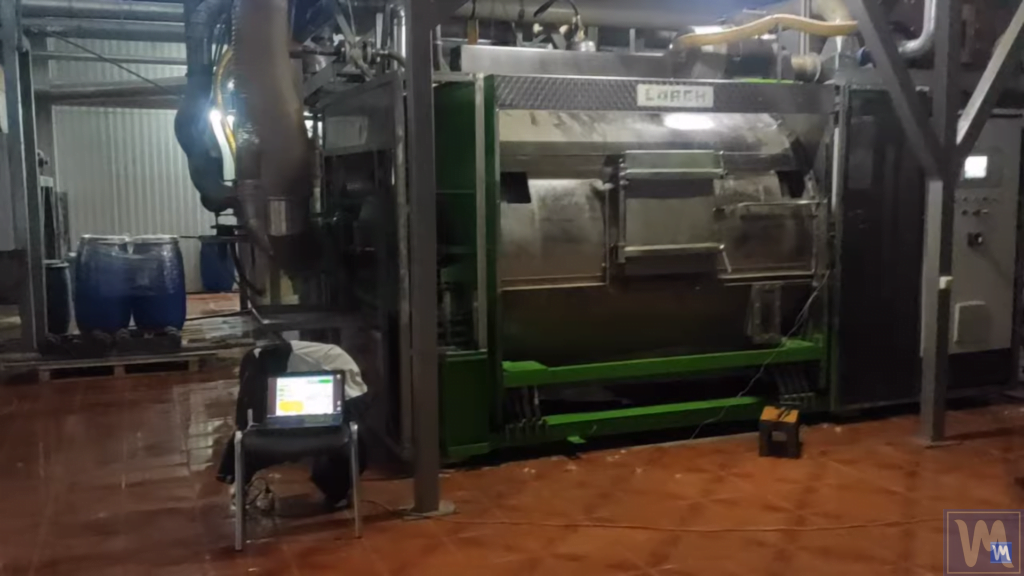
Tại sao máy ly tâm không cân bằng lại là một vấn đề lớn
Máy ly tâm mất cân bằng không chỉ là một bất tiện nhỏ; nó còn đe dọa đến sức khỏe thiết bị và hiệu quả hoạt động của bạn. Dưới đây là những vấn đề chính do rung động quá mức gây ra:
- Hao mòn nhanh hơn: Rung động khiến các bộ phận như ổ trục, trục, phớt và giá đỡ chịu áp lực lặp đi lặp lại. Điều này dẫn đến hao mòn nhanh hơn, hỏng hóc thường xuyên hơn và tuổi thọ của máy ly tâm ngắn hơn. Về mặt tài chính, bạn sẽ phải chi nhiều tiền hơn cho phụ tùng thay thế và sửa chữa, đồng thời phải chịu nhiều thời gian ngừng hoạt động hơn.
- Chất lượng sản phẩm giảm: Nhiều máy ly tâm (đặc biệt là trong các ngành công nghiệp hóa chất, dược phẩm hoặc chế biến thực phẩm) được sử dụng để tách hoặc xử lý vật liệu. Độ rung có thể làm gián đoạn quá trình tách mịn các thành phần. Ví dụ, một máy ly tâm không cân bằng có thể không tách được chất lỏng và chất rắn một cách sạch sẽ, dẫn đến chất lượng đầu ra thấp hơn hoặc kết quả không đồng đều. Trong những trường hợp nghiêm trọng (như trong sản xuất dược phẩm), điều này có thể làm hỏng toàn bộ lô sản phẩm.
- Tiếng ồn tăng cao và người vận hành mệt mỏi: Máy ly tâm rung thường tạo ra tiếng ồn lớn, ù ù hoặc lạch cạch. Điều này không chỉ vi phạm tiêu chuẩn tiếng ồn tại nơi làm việc, gây khó chịu hoặc thậm chí nguy hiểm cho nhân viên, mà còn góp phần gây mệt mỏi và căng thẳng cho người vận hành. Theo thời gian, tiếng ồn và độ rung quá mức có thể làm giảm sự tập trung và tinh thần của người lao động.
- Thiệt hại về cấu trúc và rủi ro an toàn: Rung động mạnh có thể làm lỏng bu lông và làm nứt hoặc xuống cấp nền móng máy. Toàn bộ cấu trúc của máy ly tâm, thậm chí cả bệ đỡ máy, đều có thể bị ảnh hưởng. Trong trường hợp xấu nhất, một bộ phận của máy ly tâm có thể bị vỡ do ứng suất, dẫn đến hỏng hóc nghiêm trọng. Rủi ro an toàn ở đây không thể xem nhẹ - một rotor tốc độ cao bị vỡ có thể gây thiệt hại nghiêm trọng cho cơ sở và đe dọa tính mạng con người.
Bottom line: Việc bỏ qua độ rung trong máy ly tâm sẽ khiến bạn tốn kém. Nó có thể dẫn đến thời gian ngừng hoạt động tốn kém (hãy tưởng tượng việc phải dừng sản xuất để sửa chữa khẩn cấp), chi phí bảo trì cao hơn, và có khả năng xảy ra các sự cố về trách nhiệm pháp lý hoặc an toàn sức khỏe. Đó là lý do tại sao việc cân bằng và bảo trì chủ động là rất cần thiết.
Khi tốc độ quay tăng lên, tác động của ngay cả sự mất cân bằng nhỏ cũng trở nên nghiêm trọng hơn theo cấp số nhân. Nếu bạn tăng gấp đôi tốc độ của máy ly tâm, lực mất cân bằng sẽ tăng gấp bốn lần. Đây là lý do tại sao máy ly tâm công nghiệp tốc độ cao nhất thiết phải được cân bằng chính xác — một rung động nhẹ ở tốc độ thấp có thể trở thành rung lắc dữ dội ở tốc độ vận hành tối đa.
Balanset-1A: Your Reliable Assistant in Centrifuge Balancing
Vậy, làm thế nào để giải quyết vấn đề rung động hiệu quả? Câu trả lời là cân bằng rotor của máy ly tâm, và công nghệ hiện đại giúp quá trình này trở nên dễ dàng hơn bao giờ hết. Balanset-1A là một thiết bị phân tích rung động di động và thiết bị cân bằng động được thiết kế đặc biệt cho các rôto như trong máy ly tâm (cũng như quạt, máy nghiền, tua bin và các máy công nghiệp khác). Về cơ bản, đây là một bộ công cụ cho phép bạn thực hiện cân bằng chuyên nghiệp. tại trang web của bạnmà không cần phải tháo rời máy và vận chuyển rôto đến cơ sở chuyên dụng.
Các tính năng chính của Balanset-1A: Thiết bị này đi kèm với cảm biến gia tốc kép để đo độ rung trên hai mặt phẳng, máy đo tốc độ laser để phát hiện tốc độ quay và pha, cùng phần mềm cân bằng thân thiện với người dùng. Trong chế độ rung kế, Balanset-1A có thể hoạt động như một máy đo độ rung để cung cấp cho bạn mức độ rung tổng thể và thậm chí cả phổ FFT để chẩn đoán các vấn đề. Trong chế độ cân bằng, nó hướng dẫn bạn thêm một quả cân thử và sau đó tính toán các quả cân hiệu chỉnh chính xác cần thiết để khắc phục sự mất cân bằng. Thiết bị hỗ trợ cả cân bằng một mặt phẳng (tĩnh) và hai mặt phẳng (động), đáp ứng nhu cầu của hầu hết tất cả các loại máy ly tâm. Với Balanset-1A, bạn có thể đạt được sự cân bằng chính xác trong thời gian ngắn, giảm độ rung xuống mức an toàn theo tiêu chuẩn ISO.
Điều quan trọng là việc cân bằng tại chỗ bằng thiết bị di động như thế này đồng nghĩa với việc giảm thiểu thời gian ngừng hoạt động — bạn không phải tháo rotor hoặc chờ đợi nhiều ngày để được bảo dưỡng bên ngoài. Điều này giúp tiết kiệm thời gian và chi phí vận hành. Nhiều đội bảo trì và kỹ sư dịch vụ luôn có sẵn một thiết bị cân bằng như vậy vì nó biến một công việc sửa chữa phức tạp (gửi rotor) thành một nhiệm vụ bảo trì định kỳ có thể được thực hiện tại chỗ.
Cách cân bằng rotor máy ly tâm công nghiệp (Từng bước)
Hãy cùng tìm hiểu quy trình cân bằng. Chúng tôi sẽ phác thảo các bước chẩn đoán và cân bằng máy ly tâm bằng thiết bị Balanset-1A. Ngay cả khi bạn có một thiết bị cân bằng khác hoặc chỉ muốn hiểu quy trình, những bước này sẽ giúp bạn hình dung rõ ràng cách cân bằng rotor. Quy trình bao gồm hai phần: kiểm tra cân bằng trước (để đảm bảo không có gì khác sai sót với máy) và quá trình cân bằng động chính nó. Luôn nhớ tuân thủ các quy trình an toàn: dừng làm việc khi máy đã dừng bất cứ khi nào gắn tạ hoặc cảm biến và đeo thiết bị bảo hộ thích hợp (như kính bảo vệ mắt và đảm bảo nắp bảo vệ hoặc vỏ bọc của máy ly tâm được lắp đúng vị trí trong quá trình chạy thử).
Kiểm tra và chuẩn bị trước khi cân bằng
- Đo độ rung hiện tại (Đường cơ sở): Bắt đầu bằng cách đo mức độ rung của máy ly tâm ở trạng thái hoạt động bình thường. Sử dụng Balanset-1A ở chế độ máy đo độ rung (hoặc bất kỳ máy đo độ rung nào), hãy ghi lại biên độ rung động tổng thể. Cũng lưu ý độ rung ở tốc độ chạy ( 1× thành phần quay(mà Balanset-1A có thể phân lập). Điều này sẽ cho bạn biết mức độ mất cân bằng nghiêm trọng như thế nào. Ví dụ, nếu độ rung tổng thể của bạn là, giả sử, 6 mm/giây RMS và chủ yếu đến từ thành phần 1×, thì đó là dấu hiệu rõ ràng của sự mất cân bằng.
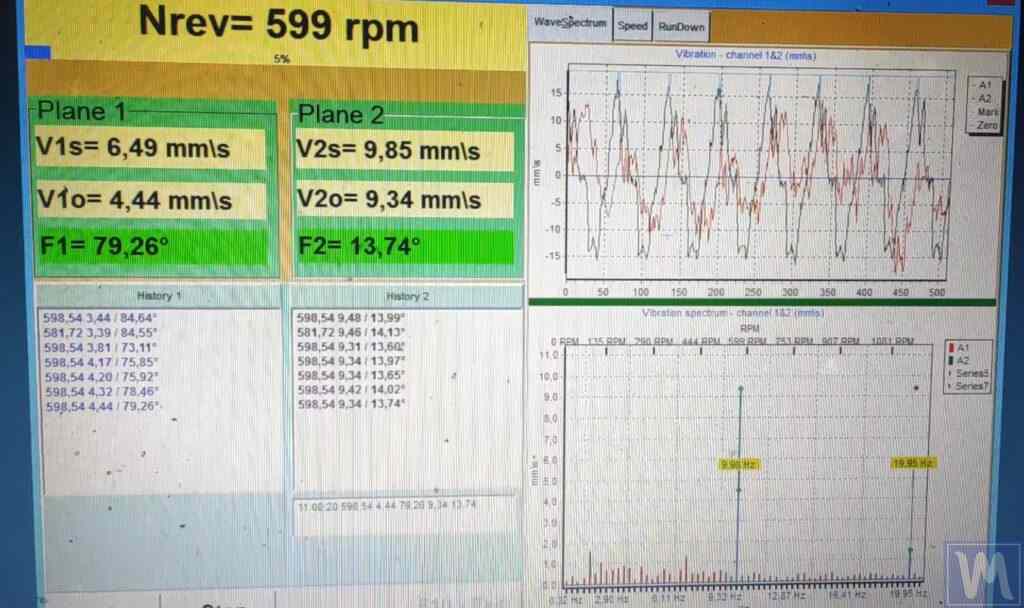
- So sánh độ rung tổng thể và độ rung quay: Kiểm tra tỷ lệ giữa tổng độ rung động chung và độ rung động ở tần số quay. Nếu các giá trị này gần bằng nhau, điều đó có nghĩa là phần lớn độ rung động là do mất cân bằng rotor (đây là tin tốt—bạn có thể khắc phục bằng cách cân bằng). Nếu độ rung động chung cao hơn nhiều so với thành phần quay, có thể có các nguồn rung động khác (như động cơ bị lệch, cộng hưởng hoặc vật gì đó bị lỏng). Trong ví dụ của chúng ta, nếu 6 mm/giây tổng thể bằng ~5,5 mm/giây ở 1×, thì sự mất cân bằng là vấn đề chính. Nhưng nếu tổng thể là 10 mm/giây trong khi 1× là 3 mm/giây, thì có thể có nguyên nhân khác gây ra độ rung động.
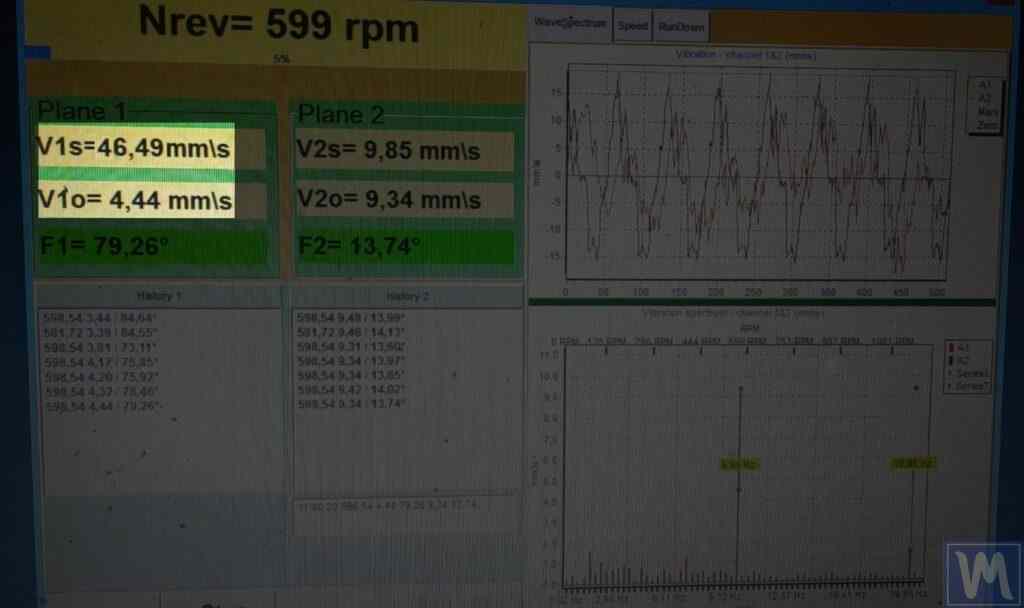
- Kiểm tra cơ chế ly tâm: Trước khi thêm tạ và cân bằng, hãy kiểm tra xem máy có vấn đề gì về cơ học không:
- Tình trạng vòng bi: Kiểm tra độ mòn hoặc độ rơ của ổ trục. Ổ trục hỏng có thể gây ra rung động mạnh hơn và cần phải thay thế; việc cân bằng rôto sẽ không khắc phục được ổ trục bị hỏng.
- Lắp đặt và hỗ trợ: Đảm bảo máy ly tâm được bắt chặt bằng bu lông và bộ giảm chấn hoặc giá đỡ còn nguyên vẹn. Bất kỳ sự lỏng lẻo nào ở đây đều có thể gây ra rung động mất cân bằng.
- Khoảng hở rotor: Quay rotor bằng tay (khi tắt nguồn) để đảm bảo nó không cọ xát vào bất kỳ bộ phận cố định nào. Đôi khi, chỉ cần một va chạm nhẹ hoặc cọ xát cũng có thể gây ra độ rung lớn khi chạy.
- Tính nhất quán của các số đọc: Khi đo độ rung ở bước 1, kết quả đo có ổn định (trong khoảng 10-15%) mỗi lần không? Biến động lớn có thể chỉ ra các vấn đề không liên tục như lỗi điện hoặc dịch chuyển linh kiện. Độ ổn định của kết quả đo độ rung cho phép bạn tự tin tiến hành cân bằng.
- Chuẩn bị cân bằng: Nếu không phát hiện vấn đề mất cân bằng đáng kể nào ở trên, hãy chuẩn bị cho việc cân bằng. Việc này bao gồm vệ sinh rotor (loại bỏ bụi bẩn, sản phẩm khô hoặc dầu mỡ có thể ảnh hưởng đến cân bằng) và đảm bảo bạn có thể tiếp cận rotor để gắn vật nặng. Đánh dấu các điểm tham chiếu trên rotor (nhiều người sử dụng băng phản quang hoặc phấn đánh dấu làm mốc 0° để đo pha). Chuẩn bị thiết bị Balanset-1A, máy tính xách tay và đảm bảo bạn có thể chạy máy ly tâm ở tốc độ cao để kiểm tra một cách an toàn. Ở giai đoạn này, bạn đã sẵn sàng để bắt đầu quy trình cân bằng thực tế.
Important: Vệ sinh kỹ rotor và bên trong máy ly tâm trước khi cân bằng. Ngay cả những cặn bẩn nhỏ cũng có thể gây mất cân bằng nhẹ hoặc rơi ra trong quá trình cân bằng, làm sai lệch kết quả. Ngoài ra, hãy luôn kiểm tra kỹ xem tất cả các bộ phận (như bát, nắp hoặc bất kỳ bộ lọc nào) đã được lắp đặt và cố định đúng cách theo hướng dẫn của nhà sản xuất hay chưa trước khi bắt đầu.
Bằng cách thực hiện các bước chuẩn bị này, bạn đảm bảo rằng:
- Bạn đang giải quyết đúng vấn đề (sự mất cân bằng thực sự so với lỗi khác).
- Máy ly tâm có kết cấu cơ học đủ tốt để cân bằng (việc cân bằng một máy bị hỏng là không hiệu quả).
- Các phép đo cân bằng của bạn sẽ chính xác (không có cục đất hoặc bộ phận rời nào làm chúng bị lệch).
Quy trình cân bằng động với Balanset-1A
- Lắp đặt cảm biến rung: Gắn các cảm biến gia tốc kế Balanset-1A vào máy ly tâm. Thông thường, bạn lắp một cảm biến trên hoặc gần vỏ ổ trục trước và một cảm biến trên vỏ ổ trục sau (để cân bằng hai mặt phẳng). Các cảm biến phải được cố định chắc chắn (thường bằng nam châm hoặc chốt) vuông góc với trục rotor. Vị trí này cho phép chúng thu nhận rung động hiệu quả. Đảm bảo cáp cảm biến được cố định chắc chắn, tránh xa các bộ phận chuyển động.
- Đính kèm dấu tham chiếu phản chiếu: Dán một dải băng phản quang hoặc đánh dấu một điểm nhỏ trên rotor (hoặc giỏ/trống quay) để làm điểm tham chiếu cho máy đo tốc độ. Điểm này sẽ cho phép cảm biến quang học của Balanset-1A phát hiện tốc độ quay và góc pha của sự mất cân bằng.
- Thiết lập máy đo tốc độ (cảm biến quang học): Đặt máy đo tốc độ vòng quay laser của Balanset-1A sao cho có thể nhìn rõ vạch phản quang trên rô-to mỗi khi rô-to quay. Một chân đế từ tính có thể giúp giữ cảm biến ổn định. Đảm bảo khoảng cách và góc đặt cảm biến phù hợp với thông số kỹ thuật của cảm biến (thường cách vạch vài inch, hướng trực tiếp vào vạch). Khi được đặt đúng cách, bạn sẽ nhận được số vòng quay vòng/phút ổn định khi rô-to quay.
- Kết nối và cấu hình thiết bị: Cắm cảm biến rung và máy đo tốc độ vào giao diện Balanset-1A (giao diện này kết nối với máy tính xách tay của bạn qua USB). Khởi chạy phần mềm Balanset và nhập dữ liệu ban đầu: chọn chế độ cân bằng hai mặt phẳng (vì máy ly tâm thường cần chế độ này), và nhập các thông số chi tiết của rotor như bán kính có thể thêm trọng lượng, và khối lượng của khối lượng "thử nghiệm" bạn định sử dụng. Ngoài ra, hãy cài đặt tốc độ chạy của máy nếu cần và đảm bảo thiết bị đang đọc chính xác độ rung và vòng tua máy (RPM) trong phần mềm.
- Bắt đầu chương trình cân bằng: Sau khi kết nối mọi thứ, bạn đã sẵn sàng để bắt đầu đo lường. Trong phần mềm, hãy tiến hành đo lường ban đầu (thường được gọi là chạy thử hoặc chạy đường cơ sở). Bạn sẽ chạy máy ly tâm đến tốc độ hoạt động bình thường. Balanset-1A sẽ ghi lại biên độ rung ban đầu và góc pha trên mỗi cảm biến (mỗi mặt phẳng). Đây là ảnh chụp nhanh "trước" của chúng tôi về sự mất cân bằng.
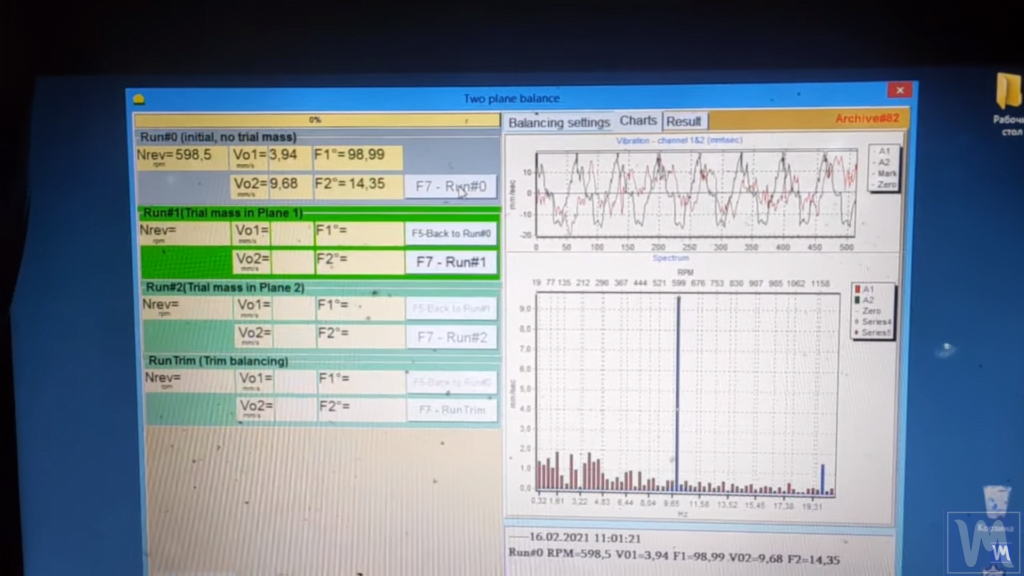
- Chọn chế độ cân bằng: Đảm bảo phần mềm biết bạn sẽ thực hiện cân bằng động (hai mặt phẳng). Điều này có thể đã được thiết lập ở bước 4, nhưng hãy kiểm tra lại. Ở chế độ hai mặt phẳng, thiết bị sẽ yêu cầu bạn thực hiện hai lần thử nghiệm với một quả cân thử (một quả cho mỗi mặt phẳng hiệu chỉnh). Thông thường, phần mềm cũng sẽ nhắc bạn về bất kỳ thao tác căn chỉnh hoặc hiệu chuẩn nào cần thiết (ví dụ: xác nhận hướng cảm biến hoặc tham chiếu pha).
- Nhập dữ liệu cho trọng lượng thử nghiệm: Chọn một quả cân thử phù hợp (ví dụ: một bu lông nhỏ hoặc một quả cân có khối lượng đã biết, có thể vài trăm gram, tùy thuộc vào kích thước rô-to). Phần mềm sẽ yêu cầu giá trị của quả cân này. Hãy nhập chính xác trọng lượng (và đôi khi là bán kính mà quả cân sẽ được gắn vào, nếu phần mềm yêu cầu). Thông tin này rất quan trọng vì chương trình cân bằng sẽ sử dụng nó để tính toán mức độ ảnh hưởng của quả cân đó đến độ rung.
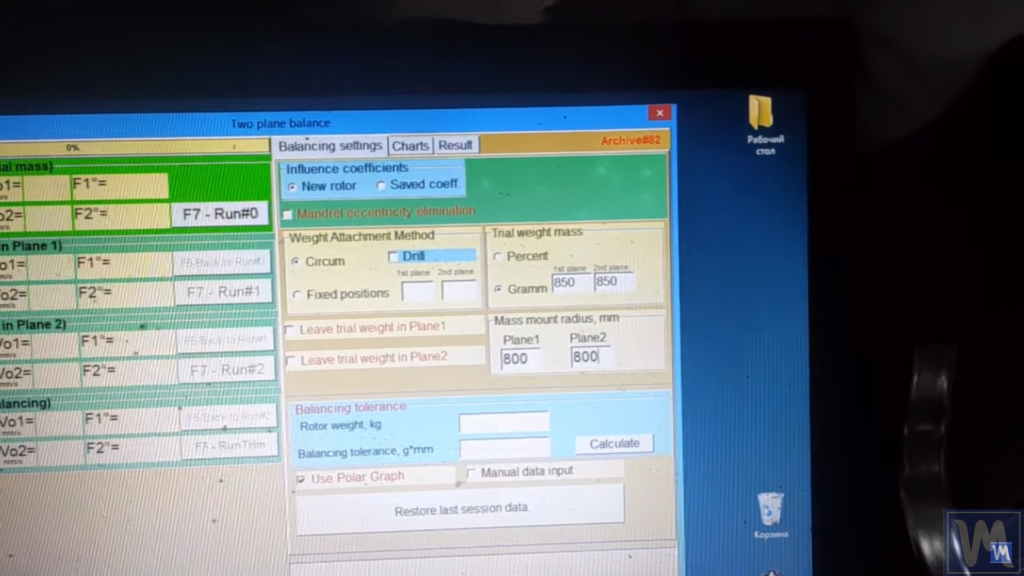
- Đính vật thử vào mặt phẳng đầu tiên: Khi máy ly tâm đã dừng và nguồn điện được ngắt, hãy gắn quả cân thử vào rotor tại vị trí được chỉ định là mặt phẳng 1 (ví dụ: đầu trước của rotor). Cố định nó ở một góc đã biết - nhiều máy cân bằng khuyên bạn nên bắt đầu từ 0° (căn chỉnh với vạch phản quang) để đảm bảo độ đồng đều. Đảm bảo quả cân được gắn chặt để nó không bị văng ra khi quay.
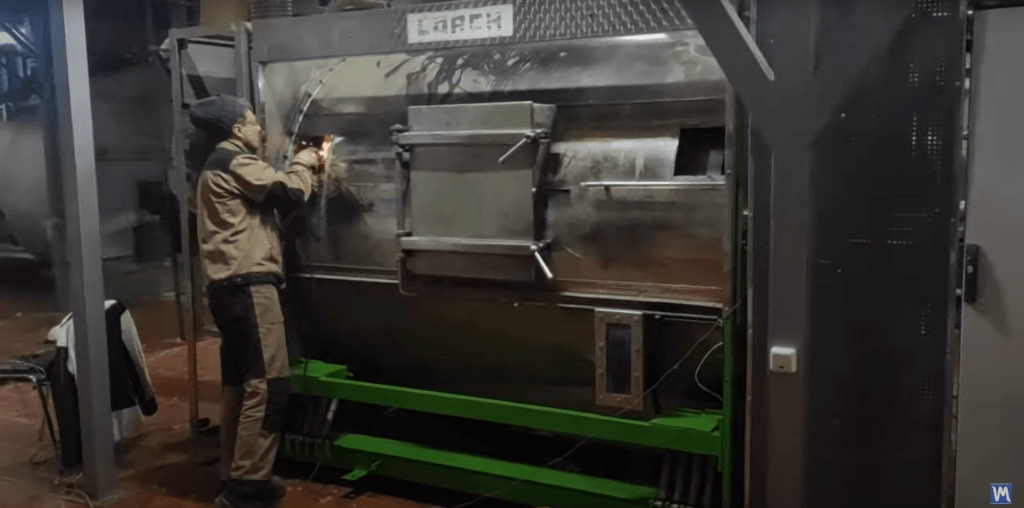
- Khởi động lại máy ly tâm và đo độ rung bằng quả cân thử: Khởi động lại máy và để máy đạt tốc độ như trước. Lúc này, sự mất cân bằng của rotor đã thay đổi do trọng lượng tăng thêm. Balanset-1A sẽ đo biên độ rung và góc pha mới. Thông thường, bạn sẽ thấy sự thay đổi trong giá trị đo của một hoặc cả hai cảm biến. Sau khi thu thập dữ liệu, hãy dừng máy ly tâm. Nhập hoặc xác minh trong phần mềm góc đặt quả cân thử nghiệm (nếu hệ thống yêu cầu nhập thủ công - một số hệ thống tự động theo dõi pha).
- Di chuyển trọng lượng thử nghiệm đến mặt phẳng thứ hai: Tháo quả nặng thử nghiệm khỏi mặt phẳng 1 và gắn nó vào mặt phẳng 2 (ví dụ, đầu đối diện của rotor). Nếu có thể, hãy đặt nó ở cùng một góc (tham chiếu 0°) ở đầu đó. Sự nhất quán này giúp việc tính toán dễ dàng hơn. Hãy đảm bảo nó được cố định chắc chắn.
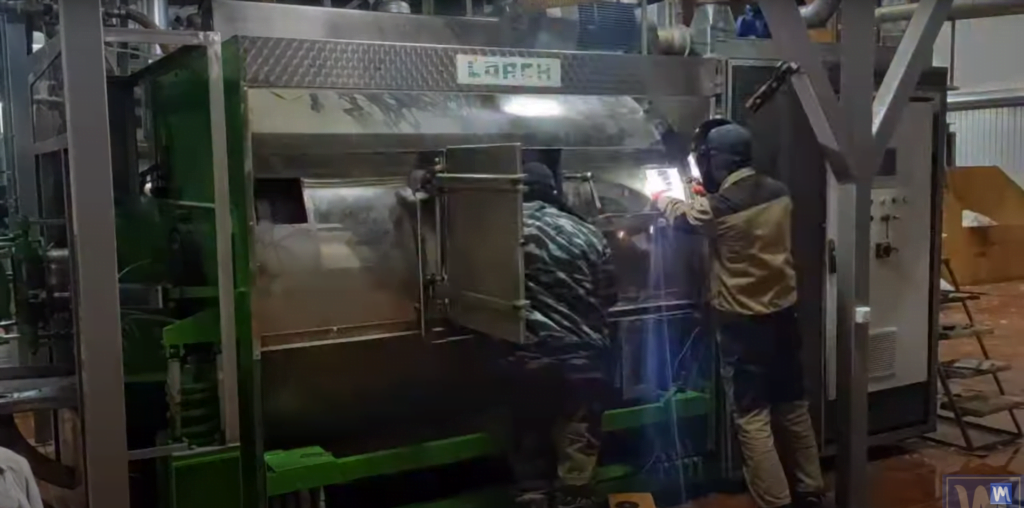
- Tiến hành ly tâm với khối lượng thử trên mặt phẳng 2: Khởi động lại máy một lần nữa và để máy ổn định ở tốc độ vận hành. Balanset-1A sẽ thực hiện một loạt phép đo khác, phản ánh cách trọng lượng thử nghiệm ảnh hưởng đến mặt phẳng thứ hai. Sau khi thu thập dữ liệu này, hãy dừng máy ly tâm. Lúc này, thiết bị đã có thông tin về cách trọng lượng đã biết ảnh hưởng đến độ rung ở cả hai mặt phẳng hiệu chỉnh.
- Tính toán trọng số hiệu chỉnh: Phần mềm Balanset sẽ tính toán các trọng số hiệu chỉnh cần thiết và vị trí góc của chúng cho mỗi mặt phẳng. Về cơ bản, nó sẽ tính toán lượng đối trọng cần thiết để trung hòa các điểm nặng. Ví dụ, kết quả đầu ra có thể là "Mặt phẳng 1: 50 gram ở góc 135°, Mặt phẳng 2: 60 gram ở góc 270°" (chỉ để minh họa). Đây là các trọng số bạn cần thêm vào để cân bằng rotor. Tháo quả cân thử ra (đừng quên bước này — nếu để nguyên nó sẽ làm hỏng cân!).
- Chuẩn bị và lắp đặt các quả cân bù: Bây giờ, hãy lấy các quả cân hiệu chỉnh thực tế theo tính toán (bạn có thể sử dụng bu lông, vòng đệm hoặc quả cân cân bằng chuyên dụng) và gắn chúng vào rotor. Nếu rotor có lỗ khoan sẵn hoặc vòng cân bằng, hãy sử dụng chúng. Nếu không, bạn có thể phải cố định các quả cân bằng bằng kẹp hoặc hàn (tùy thuộc vào thiết kế rotor và phương pháp hiệu chỉnh cân bằng cố định). Điều quan trọng là đặt khối lượng đã chỉ định vào đúng vị trí góc đã chỉ định. Sử dụng thước đo góc hoặc thước đo góc tích hợp của thiết bị để xác định chính xác vị trí so với vạch tham chiếu của bạn.
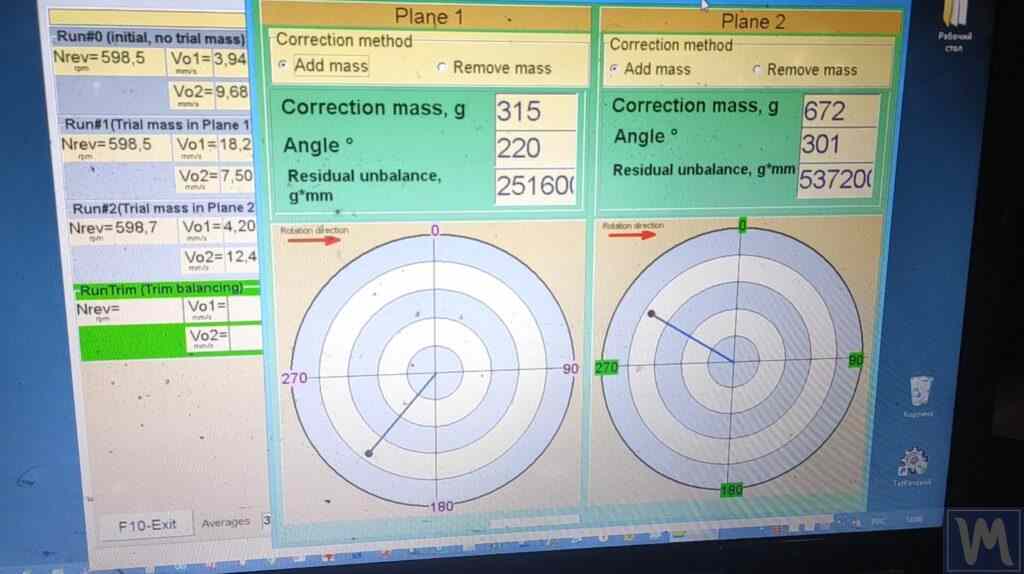
- Chạy thử (xác minh): Sau khi các quả cân mới được đặt đúng vị trí, đã đến lúc thực hiện phép thử. Chạy máy ly tâm ở tốc độ cao một lần nữa và đo độ rung bằng Balanset-1A. Nếu mọi thứ được thực hiện chính xác, bạn sẽ thấy biên độ rung giảm đáng kể trên cả hai mặt phẳng. Lý tưởng nhất là độ mất cân bằng còn lại rất thấp (thậm chí máy có thể kêu "rít"). Kiểm tra xem mức độ rung hiện có nằm trong các tiêu chuẩn chấp nhận được hay không (ví dụ: dưới ngưỡng mm/giây do công ty bạn chỉ định hoặc trong cấp chất lượng cân bằng ISO cho loại rôto đó). Nếu độ rung vẫn cao hơn mục tiêu một chút, phần mềm có thể cho phép chạy tinh chỉnh — nhưng thường thì một vòng là đủ để cải thiện đáng kể. Ngoài ra, hãy lắng nghe và cảm nhận: máy ly tâm sẽ phát ra âm thanh và có cảm giác mượt mà hơn nhiều. Cuối cùng, hãy đảm bảo rằng tất cả các quả cân được thêm vào đều được cố định chắc chắn để hoạt động liên tục.
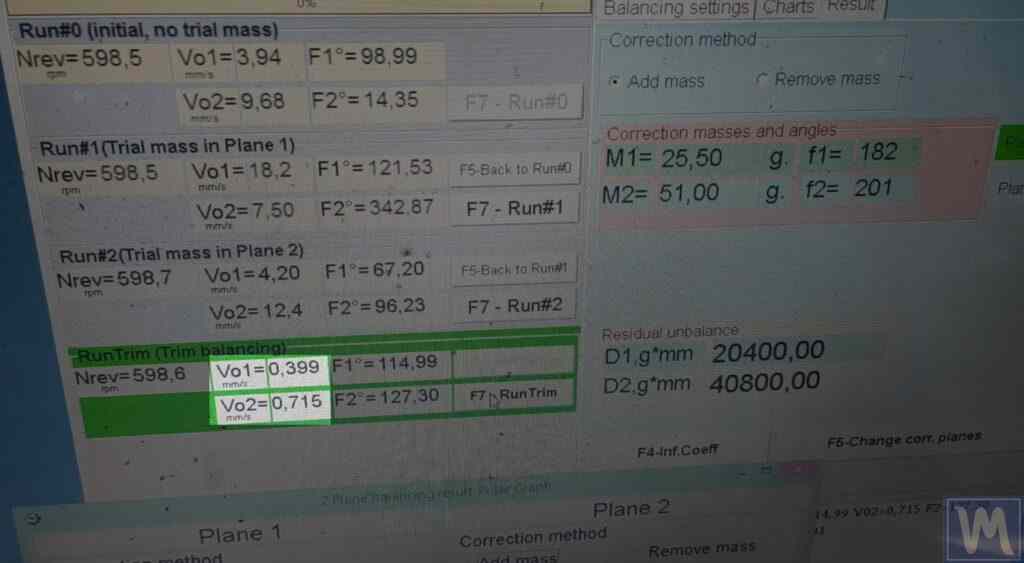
Kết luận: Hoạt động trơn tru và lợi ích lâu dài
Việc cân bằng rotor máy ly tâm không chỉ là một bài tập lý thuyết – nó mang lại lợi ích thiết thực cho hoạt động của bạn. Bằng cách loại bỏ rung động quá mức, bạn:
- Đảm bảo độ tin cậy: Máy ly tâm cân bằng hoạt động trơn tru mà không bị rung lắc, giảm thiểu tối đa sự cố bất ngờ. Điều này đồng nghĩa với việc thời gian hoạt động lâu hơn và quy trình sản xuất ổn định.
- Kéo dài tuổi thọ thiết bị: Nhờ giảm độ rung, các bộ phận quan trọng như ổ trục và phớt sẽ bền hơn. Toàn bộ máy ít chịu áp lực hơn, giúp tăng thêm tuổi thọ sử dụng.
- Cải thiện chất lượng và độ chính xác: Khi máy ly tâm không phải xử lý sự mất cân bằng, nó sẽ thực hiện nhiệm vụ của mình - tách hoặc xử lý vật liệu - một cách chính xác hơn. Bạn sẽ có được độ đồng nhất của sản phẩm tốt hơn, dù đó là đầu ra khô hơn từ máy ly tâm tách nước hay sự phân tách đồng đều hơn trong quy trình hóa học.
- Giảm mức độ tiếng ồn: Máy ly tâm cân bằng tốt sẽ phát ra tiếng kêu rừ rừ thay vì tiếng ồn. Môi trường làm việc trở nên yên tĩnh và an toàn hơn cho mọi người xung quanh. Người vận hành sẽ cảm nhận được sự khác biệt về mức độ tiếp xúc với âm thanh và độ rung.
- Tăng cường an toàn: Bạn loại bỏ nguy cơ hỏng hóc thảm khốc do mất cân bằng. Khả năng xảy ra tai nạn liên quan đến rung động thấp hơn nhiều, bảo vệ cả người và thiết bị xung quanh.
- Tiết kiệm tiền bạc và thời gian: Ít sửa chữa hơn, ít thời gian ngừng hoạt động hơn và vận hành hiệu quả hơn đều góp phần tiết kiệm chi phí. Cân bằng là một biện pháp phòng ngừa có chi phí thấp hơn nhiều so với những trường hợp khẩn cấp mà nó ngăn chặn. Việc cân bằng tại chỗ bằng thiết bị như Balanset-1A cho phép bạn giải quyết vấn đề nhanh chóng mà không phải dừng sản xuất quá lâu.
Kêu gọi hành động: Đừng để máy ly tâm mất cân bằng làm ảnh hưởng đến công việc của bạn. Nếu bạn nhận thấy vấn đề rung động, hãy hành động ngay bằng cách lên lịch kiểm tra cân bằng. Với các công cụ như Balanset-1A, giải pháp có thể nhanh chóng và hiệu quả, giúp cơ sở của bạn hoạt động tốt nhất. Cho dù bạn chọn tự cân bằng hay gọi chuyên gia, điều quan trọng là không bỏ qua các dấu hiệu cảnh báo rung động.
Thiết bị Balanset-1A giúp toàn bộ quy trình dễ tiếp cận, ngay cả với những người không có kiến thức chuyên sâu về phân tích rung động. Nó giống như có một chuyên gia bên cạnh, hướng dẫn bạn từng bước để đạt được một rotor trơn tru. Đối với các kỹ sư và đội ngũ bảo trì tại hiện trường, điều này đồng nghĩa với việc giải quyết vấn đề nhanh hơn và sản xuất tiếp tục diễn ra suôn sẻ.
Nhớ: Máy móc cân bằng là xương sống của hoạt động công nghiệp hiệu quả và an toàn. Bằng cách áp dụng các nguyên tắc và bước được nêu trong hướng dẫn này, bạn có thể đảm bảo máy ly tâm (và các thiết bị quay khác) của mình luôn ở trạng thái tốt nhất.
Balanset-1A: Trợ thủ đáng tin cậy của bạn trong việc đảm bảo hoạt động liên tục và tuổi thọ của máy ly tâm. Hãy chủ động bảo trì và tận hưởng sự an tâm khi thiết bị vận hành trơn tru và hiệu quả.
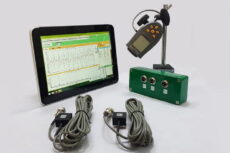
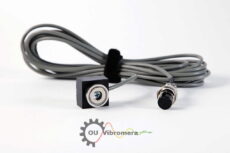
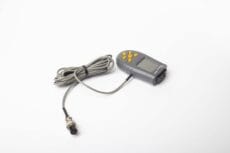
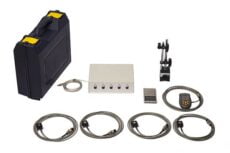


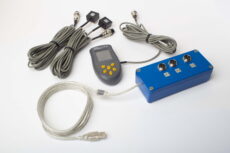
0 Bình luận